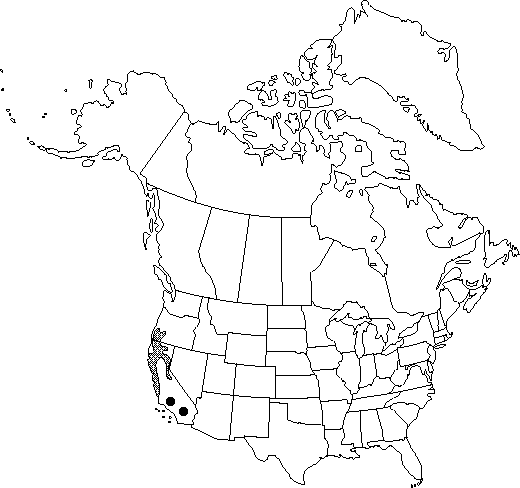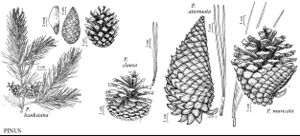Pinus attenuata
Mining Sci. Press 64: 45. 1892.
Shrubs or trees to 24m; trunk to 0.8m diam., usually straight; crown mostly narrowly to broadly conic. Bark purple-brown to dark-brown, shallowly and narrowly fissured, with irregular, flat, loose-scaly plates, on upper sections of trunk nearly smooth. Branches ascending; twigs slender, redbrown. Buds ovoid to ovoid-cylindric, dark redbrown, aging darker, ca. 1.5cm, resinous; scale margins fringed, apex attenuate. Leaves 3 per fascicle, spreading or ascending, persisting 4–5 years, (8–) 9–15 (–20) cm × (1–) 1.3–1.8mm, straight or slightly curved, twisted, yellow-green, all surfaces with fine stomatal lines, margins serrulate, apex abruptly conic-subulate; sheath (1–) 1.5–2cm, base persistent. Pollen cones ellipsoid-cylindric, 10–15mm, orangebrown. Seed-cones maturing in 2 years, serotinous, long-persistent, remaining closed for 20 years or more, or opening on burning, in whorls, hard and heavy, very asymmetric, lanceoloid before opening, ovoid-cylindric when open, 8–15cm, yellow or pale redbrown, stalks to 1cm; apophyses toward outside base increasingly elongate, mammillate or raised-angled-conic, downcurved near base, scarcely raised on branchlet side, rhombic; umbo central, low-pyramidal, sharp, upcurved. Seeds compressed-oblique-obovoid; body ca. 6–7mm, nearly black; wing narrow, to 20mm. 2n =24.
Habitat: Fire successional on dry slopes and foothills of Sierra Nevada and the Cascade and Coast ranges
Elevation: 300–1200m
Distribution

Calif., Oreg., Mexico in Baja California.
Discussion
Pinus attenuata, mostly a chaparral species, bears cones at an early age. Its seed crops are heavy, and a hot fire permits the seeds to be released. It forms hybrids with P. muricata and P. radiata.
Selected References
None.
